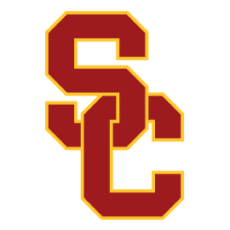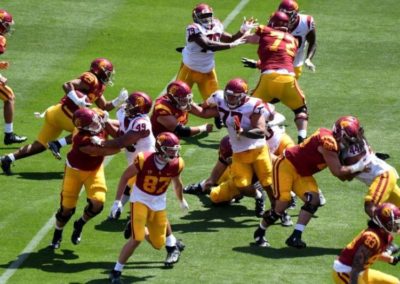5 questions facing USC football heading into summer
Between now and the Sept. 4 season opener against San Jose State, inquiring minds want to know…
Adam Grosbard (OC Register) — The month of May represents the start of a quiet period for USC football. With spring football over, the student-athletes are taking finals while coaches prepare for the resumption of in-person recruiting in June after a year of FaceTime and Zoom calls.
1. How does the offensive line shuffle unfold?
This was the most-watched position battle during the spring, and after five weeks of practices, there’s still more to unfold before we can be sure who starts for the Trojans.
Through the spring game, USC stuck with a clear first-team unit: Tackle Jalen McKenzie and guard Liam Jimmons manning the right side of the line, Brett Neilon at center, Andrew Vorhees at left guard and redshirt freshman Courtland Ford at left tackle. Ford is the only new starter among this unit, filling in for newly-drafted Alijah Vera-Tucker.
The second-team line, from left to right, was typically Casey Collier, Jason Rodriguez, Justin Dedich, Liam Douglass and Jonah Monheim. At times, Dedich would move to guard and Andrew Milek would play center.
These groups largely struggled through the first three weeks of spring, culminating with eight sacks surrendered in the spring game, albeit with shuffled lines playing in the scrimmage.
The next week, OL coach Clay McGuire said the plan all along was to evaluate the first- and second-team units through the first nine practices before testing out different combinations. Over the last two weeks, USC did that. Monheim worked at left tackle for the starters, with Ford moving to the right. Vorhees moved out to tackle with Ford sliding to guard.
There will be more experimenting to do. And potentially some addition to the position group, too. Head coach Clay Helton said in his final press conference of the spring that USC has some scholarship openings, though he sidestepped a question about how the team may want to use them. But given how the offensive line struggled through much of the spring, a reinforcement or two might be in order.
2. How does the running back battle play out?
USC wants to move away from the running back-by-committee approach it’s used the last three seasons. The goal is for one main back and a change-of-pace option to take on the lion’s share of carries.
With just two jobs on the line, that makes running back the most crowded competition at USC. Texas transfer Keaontay Ingram was the best back throughout the spring, breaking tackles and bursting through holes. If he’s the physical workhorse (which is still TBD until after fall camp), how does USC complement him?
Vavae Malepeai plays with a similar style to Ingram, but has been USC’s starting running back the last two seasons when healthy. Stephen Carr is more of a contrast with Ingram, with speed being his primary weapon. Kenan Christon is the most dynamic option, with his combination of speed and ability to make plays in the passing game, but he missed spring competing with the USC track and field team and faces an uphill battle.
3. How does USC manage snaps at defensive line?
This position group had the best spring of any at USC. It was disruptive on nearly every play, overwhelming the offensive line, giving running backs little room and quarterbacks little time to operate. It’s a deep, talented unit even after the departures of Marlon Tuipulotu and Caleb Tremblay, which also means position coach Vic So’oto has a lot of mouths to feed.
The logjam starts at defensive end. USC returns starter Nick Figueroa and sophomore Tuli Tuipulotu, who had one of the best spring by any account, using his sheer strength to dominate practices. Jacob Lichtenstein is back after opting out of the first four games of last season and also impressed the coaching staff during camp.
This position group is further complicated by the arrival this summer of the nation’s top recruit, Corona Centennial’s Korey Foreman. It’s possible that the athletic Foreman plays more at the hybrid outside linebacker position than end this season. But that would mean taking snaps away from the team’s best defensive player, Drake Jackson, so that seems unlikely.
At tackle, Jamar Sekona and Jay Toia had breakout performances during the spring. But Alabama DT transfer Ishmael Sopsher will be back this fall after missing spring due to compartment syndrome surgery.
So’oto basically played his starters every snap last season, but that isn’t ideally how he wants the line rotation to look. He’d rather have two units that can switch in and out together. That seems the likely solution to this problem, but even then there are six jobs to win.
4. Who can USC rely on at cornerback?
USC returns one starting corner from last season, junior Chris Steele. It also returns reserves Isaac Taylor-Stuart and Dorian Hewett and has converted receiver Josh Jackson in the mix.
Those are all the cornerbacks who ended spring healthy, with Jayden Williams (hamstring) and Adonis Otey both suffering injuries that limited them.
This laid bare how thin USC is at the corner position. If Steele suffers an unexpected injury, the Trojans will suddenly be required to rely on unproven options.
In his final press conference of spring, Helton said he was looking forward to getting the rest of the 2021 recruiting class on campus to reinforce this position group. But will Ceyair Wright, Prophet Brown or Jaylin Smith be ready to contribute in a meaningful way if push comes to shove? That remains to be seen.
5. Who backs up Kedon Slovis?
USC doesn’t have a starting quarterback competition entering this camp, but the Trojans will need to decide on a backup for the junior Slovis before the season opener. With senior Mo Hasan out for the season with an ACL tear, it will come down to true freshmen Jaxson Dart and Miller Moss.
Dart looked like the readier of the two throughout the spring, with impressive throws and an ability to run that adds a new wrinkle to the offense when he’s at QB. But his readiness in comparison to Moss is to be expected: Dart played a senior year of high school in Utah, while Moss could not due to restrictions in California.
Moss’ confidence grew as camp progressed, though, with a couple of strong practices to close out the spring. Helton will keep the competition open until the day before the regular-season opener, so Moss will get the chance to prove he earns the job.
__________

